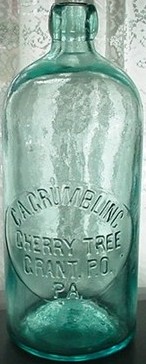Featured Bottler: C. A. Grumbling - Cherry Tree, Pennsylvania
Note: If you have researched and authored an article about a Hutchinson bottler you feel would be of interest to others, and would like the article considered for publication on HutchBook.com, please contact us via EMail at HutchBook@yahoo.com.
Posted: June 1, 2013 (Updated 07-01-13)
C. A. GRUMBLING - CHERRY TREE, PENNSYLVANIA by
Ron Fowler
During the process of cataloguing over 17,600 Hutchinsons we have noted a wide and interesting variety of city and town names. A few of the names instantly fuel the need to learn something about their source. That is exactly what happened while cataloguing PA0428.5, the illustrated quart Hutchinson embossed C. A. GRUMBLING / CHERRY TREE / GRANT, P.O. / PA. Say, what? What kind of address is that?
Unfortunately, we currently lack the time to properly research Grumbling via primary resources, but perhaps someone living in that area can do some legwork for us and provide historical information about the bottler. In addition to the illustrated quart, Grumbling also utilized pint and 20 ounce Hutchinsons (PA0427 and PA0428). All three variants are Rare. The illustrated quart was recently listed at an on-line auction site. It drew 11 bids from five bidders and sold for a cool $935.00.
Here's some brief information from Wikipedia providing a partial explanation of the borough's name:
Cherry Tree is a
borough in
Indiana County,
Pennsylvania,
United States. The
population was 364 at the
2010 census…
Cherry Tree was
originally known as "
Cherry Tree was
named for a large cherry tree that stood at the confluence of Cush
Cushion Creek and the West Branch of the
In 1804 the
Commonwealth created the counties of Cambria,
In the year 1822,
Richard Smith settled along Cush Cushion Creek about 5 miles from the
tree. Mr. Smith was known
throughout
William Sebring
erected a frame gristmill in 1827, and in 1828 he built a sawmill a
short distance from the gristmill. In
1833 Mr. Sebring sold his mill to Peter Newman and that same year the
Post Office was moved to the Newman property in
Following the sale of
the Newman property, the Post Office was moved to the Campville side of
the river. During this time
postmasters were the spoils of political war.
Mr. E. B. Camp, a stalwart
Republican, was in charge of the Newman's Mills office during General
Grant's term as President. He
petitioned the Postmaster General to have the named changed from
Newman's mills to Grant in 1867. The
next 40 years, the mail carried the following addresses "Cherry Tree,
Grant Post Office,
Note: See additional information in the 07-01-13 edition of "Hutchinson Highlights"
 HutchBook.com
HutchBook.com